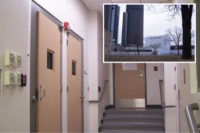Security Gets High-Tech Boost In Dallas

Video system components used outdoors by the city of Dallas are mounted inside protective weather-resistant enclosures.
Live Large. Think Big.” It’s the new slogan for the city of Dallas, Tex, and it describes the essence and vitality of a city built on big dreams, freshly blazed trails and an attitude that all things are possible. The diverse city offers a thriving culinary scene, a leading arts district, professional sports and trendy entertainment districts.
Dallas is the third-largest city in Texas and the ninth-largest in the United States. As of 2009, the population of Dallas was at 1.3 million, according to the U.S. Census Bureau. Founded in 1841 and formally incorporated as a city in February, 1856, the city’s economy is primarily based on banking, commerce, telecommunications, computer technology, energy and transportation, home to several Fortune 500 companies.
Like any large metropolitan area, the city does experience some crime. Thanks to an experienced police force, a close watch is kept on live video from 152 cameras connected via a real-time wireless mesh network, managed by sophisticated IP video surveillance software, located throughout three business districts in the busy Texas city.
Monitoring the video 24 hours a day, seven days a week are sworn active-duty police officers currently serving less than full duty because of injuries, along with retired police officers working on an hourly basis. Each monitoring station operator watches roughly 25 camera views, using one video screen to survey multiple cameras and a second screen to provide a larger view from a specific camera.
Lieutenant Tony Crawford of the Dallas Police Department compares the video monitors’ job to that of a police officer traveling the city in a car. “They sit and look for criminal activity and anything out of the ordinary,” he says. “They know from experience where their hot spots are. They know where to look, and they concentrate on those areas.”
The monitoring operators work in three eight-hour shifts per day. They can communicate using two-way radios to officers in the field, and they have access to a digital list of dispatch calls in real-time. They can pan, tilt, or zoom a camera manually for video views surrounding an incident even before the officers on the street arrive. Monitoring operators are also keenly aware that the Department of Homeland Security has listed Dallas among the top ten cities likely to be targeted by terrorist threats.
This combination of police experience and state-of-the-art technology has proven its worth to Dallas by lowering crime rates. Residents feel more secure. “We have seen a consistent drop in crime – both violent and non-violent – in areas where we have cameras,” says Crawford. “It’s a partnership that involves not only the officers on the street and the monitoring operators, but also the citizens. All three together have helped us reduce crime.”
“In areas that are specifically important to the city of Dallas, real-time video has given us the ability to provide citizens a greater sense of security,” adds Crawford. “There are signs downtown that say you are under surveillance. You can’t measure that sense of security.”
Crawford oversees the monitoring of the 152 cameras that have been installed about 20 feet off the ground on various traffic signal poles throughout the downtown, uptown and Jubilee Park business districts in Dallas. Video images from the cameras travel via IP wireless network to five servers located in city hall.
In addition to watching cameras in real-time, the monitoring personnel also cross-check crime reports against video archives to determine if a camera near the location of an alleged crime captured any evidence. If video footage of an incident exists, it is copied onto a CD. There have been 4,518 of these “camera-involved calls” through June of 2010, and there were 6,259 in 2009. Making video copies, which require supervisor approval, helped with 28 incidents through June of 2010 and with 70 incidents last year. The cameras have also been used to monitor events in real-time, for example, to watch protests for potentially violent situations. The cameras have been used to monitor 112 real-time events through June this year.
For example, in the South Dallas community of Jubilee Park a man waving at the camera quickly alerted police to a shooting incident outside of camera view. Another time, someone stole the wallet of a man having a seizure at a bus station, and the same operator saw the thief on video the very next day.
FROM 40 CAMERAS TO 152
Video surveillance of public areas began in 2007 in Dallas, and the camera count has grown steadily since then. The funding for the first 40 cameras came from the Meadows Foundation, and the Downtown Dallas Merchants Association later funded an increase in the number of cameras. BearCom, a nationwide provider of wireless communications equipment and solutions, originally designed and installed the system for the Dallas Police Department in early 2007. The company has also continued to add cameras to the system since then, continuing with 16 more cameras in Jubilee Park the same year. The next year, 2008, saw an unprecedented 27 percent reduction in crime incidents in Jubilee Park, much of it attributed to the cameras. Surveillance equipment in the Jubilee Park area and Uptown was purchased by business associations in those areas and donated to the police department. Covering the three currently monitored business districts are 107 pan-tilt-zoom (PTZ) cameras that constantly “patrol” the surrounding area using PTZ presets and covering 360 degrees. Operators can also override the presets and direct the camera wherever they want; the camera resumes its preset sequence after five minutes if not used during that time. In eight locations, a PTZ camera is coupled with a fixed camera that remains directed to a critical point no matter what happens.
A total of 152 cameras have currently been installed throughout the city of Dallas, making it one of the largest municipal wireless video surveillance systems anywhere in the country. Live video is transmitted using 165 mesh nodes from Firetide. The video is managed by Ocularis, physical security information management platform from OnSSI, which was chosen for its ease of use and advanced instant investigation tools such as the time/motion slicer engine and push video alerting. Ocularis provides mission-critical information conveniently and efficiently, allowing for fewer officers to monitor more cameras.
A key factor in selecting the wireless mesh system was its ability to handle high-quality video traffic from the video cameras. Wireless mesh met the goal of being able to read vehicle license plates at 300 yards, as well as delivering positive identification of individuals. Without wireless mesh, it would have been too difficult and cost-prohibitive to install the cameras where they were needed. In addition, mesh creates alternate wireless links so the network is extremely reliable. Even if a wireless link is blocked or a node loses power, the video will always go through without any interruption in service.
Additionally, the system provides reliability and performance in a very dense urban environment, as well as fast delivery and setup of all of the equipment. Downtown Dallas has more than 50 buildings 30 or more stories tall, a challenging RF environment.
The ease with which cameras and nodes can be moved is important, too. In fact, the self-forming nature of mesh enables portable installations for special events or temporary needs. The Dallas Police Mobile Command Center can tie into the system as long as there is a line-of-sight for the transmission.
The video traffic is backhauled to the monitoring station using high-speed, secure wireless links. Fifteen wireless point-to-point backhaul links are used to transmit data traffic aggregated from each of the meshes to the central servers.
System components are mounted outdoors, as needed, inside protective weatherproof enclosures. The system has proved reliable despite the environmental challenges of the Dallas climate, where it can be 93 degrees one day and 33 degrees the next, or can hit 105 degrees in the summer, says Crawford.
There are several servers located throughout the city, including five at city hall, one at the fire station for the Jefferson Boulevard area and another at the auto impound. Each server provides storage of 2.1 terabytes, or about 14 days of footage. Cameras have also been added at the city landfill, auto impound, and the restaurant/nightlife district known as the West End.
Rick Watson, deputy chief of police for the Southwest Division, uses 11 cameras along the Jefferson Boulevard corridor, where retail stores, mom-and-pop businesses and pawn shops are all part of a higher crime area. The cameras are not monitored in real-time, but officers routinely use the Ocularis software to review video after the fact. “If there is an offense on the corridor, say on Sunday afternoon, it is date and time-stamped, and we can go back and pull up that video,” says Watson. The year-to-date statistics for crime along the Jefferson Boulevard corridor are down 20.3 percent for violent crime and 12.1 percent for property crime, says Watson.
TO MONITOR OR NOT
Monitoring of the cameras is the greatest expense, and the Dallas Police Department has set up guidelines specifying that it will only monitor cameras that are installed in so-called Target Action Area Grid (TAAG) areas, where the crime rate is among the highest in the city. If a neighborhood or business association wants cameras in other non-TAAG areas in the future, they will have to contract with an outside firm for monitoring.Another continuing expense is maintenance. “Our biggest thing was that we didn’t take into consideration the cleaning of dust collecting on lenses,” says Crawford. Even equipment donated to the city generates ongoing maintenance costs for repair, and the city of Dallas is currently taking bids for maintenance of the existing system – one contract to cover the monitoring center and another to cover the outlying components of the system such as the cameras, mesh nodes and backhauls. The contracts would only cover repairs; additional upgrades would have to come through donations.
OPERATORS HAVE RESPONSIBILITIES
The people monitoring the systems are police patrol people, not technologists, and the Ocularis software makes it easy for a layperson to operate the system. The department used the system’s video analytics functionality when there was a highly publicized trial at the courthouse a couple of years ago. Tight courthouse security ensured that there was only one point of entry or exit, and Dallas police video monitor operators used the video analytics function to “paint” the courthouse door using the software to instantly alert operators to movement within the “painted” area.Privacy concerns have not been an issue. “Our cameras only patrol public areas,” says Crawford. “The cameras can’t pan up to look into windows or office buildings, but point down at public areas. Part of the training our camera operators go through is to ensure they do it properly. We make sure operators understand they have responsibilities; it’s the same as a police officer. It’s like they are seven-foot police officers looking down.”
Tech Partners
Dallas partners with the following companies to keep a close eye on the city:• BearCom originally designed and installed the video surveillance system for the Dallas Police Department in early 2007.
• Pan-tilt-zoom cameras from Sony and Panasonic.
• Live video is transmitted using 165 mesh nodes from Firetide.
• Fifteen wireless point-to-point (PTP) backhaul links from BridgeWave Communications are used to transmit data traffic. The city of Dallas also uses 10 Motorola PTP backhauls.
• The video is managed by Ocularis, physical security information management platform from OnSSI.
Looking for a reprint of this article?
From high-res PDFs to custom plaques, order your copy today!








